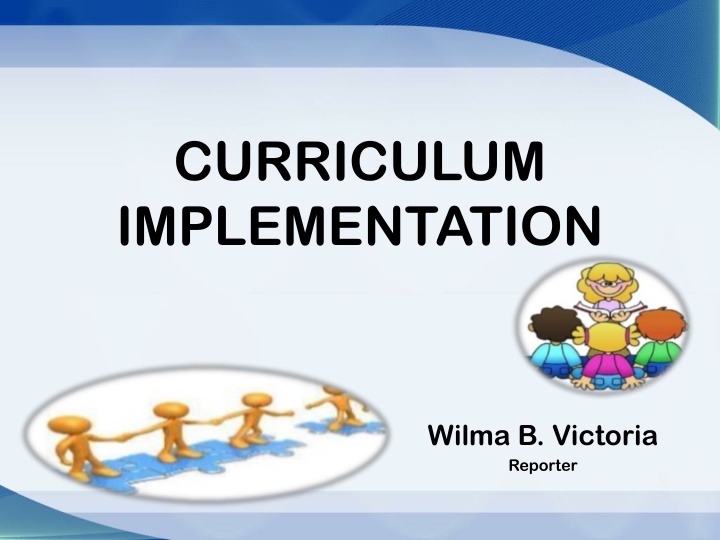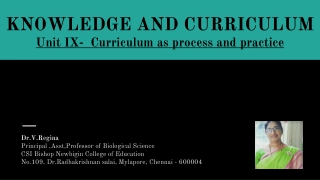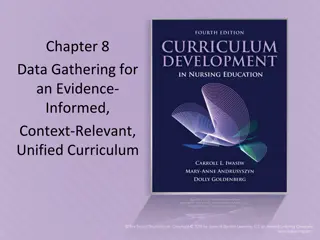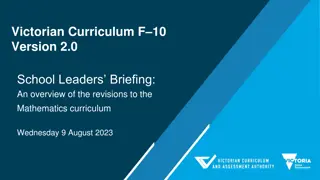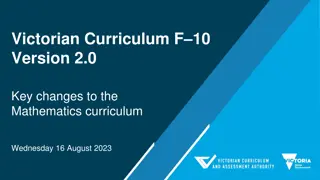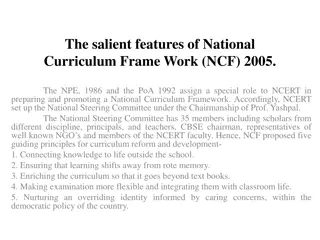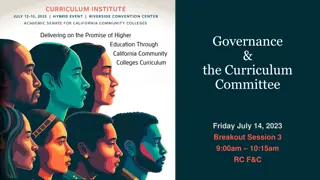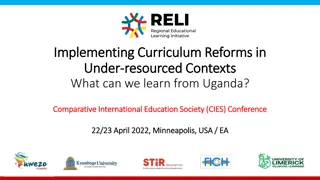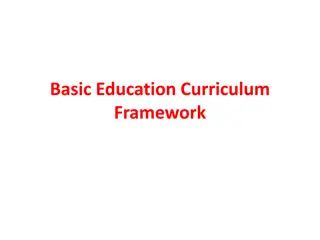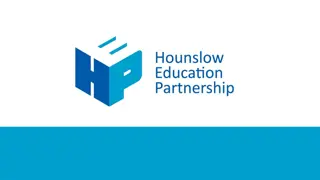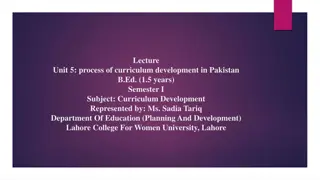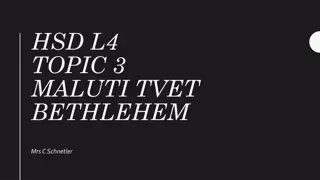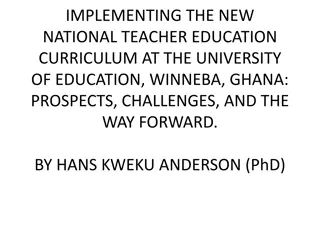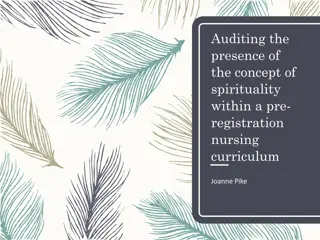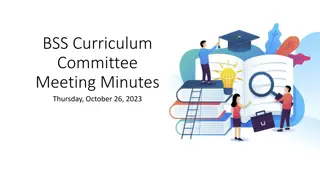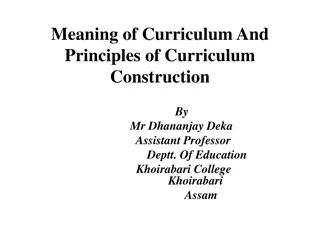Curriculum Implementation in Education
Curriculum implementation in education involves translating the planned course of study into lessons for students, focusing on shifts in knowledge, behaviors, and attitudes. Teachers play a crucial role in delivering the curriculum, with learners at the core of the educational process. Explore the interaction between written curricula and those responsible for its delivery, aiming for achievable goals through new strategies and resources. Learn from experts' definitions and insights into effective curriculum implementation practices.
Download Presentation

Please find below an Image/Link to download the presentation.
The content on the website is provided AS IS for your information and personal use only. It may not be sold, licensed, or shared on other websites without obtaining consent from the author.If you encounter any issues during the download, it is possible that the publisher has removed the file from their server.
You are allowed to download the files provided on this website for personal or commercial use, subject to the condition that they are used lawfully. All files are the property of their respective owners.
The content on the website is provided AS IS for your information and personal use only. It may not be sold, licensed, or shared on other websites without obtaining consent from the author.
E N D
Presentation Transcript
CURRICULUM IMPLEMENTATION Wilma B. Victoria Reporter
Curriculum implementation Curriculum implementation refers to how the planned or officially designed course of study is translated by the teacher into syllabi, schemes of work schemes of work and lessons to be delivered lessons to be delivered to students. syllabi,
Ornstein and Ornstein and Hunkins defined curriculum defined curriculum implementation as the implementation as the interaction between the interaction between the curriculum that has been curriculum that has been written and planned and the written and planned and the persons persons who who are in charge to are in charge to deliver it. deliver it. Hunkins in 1998 in 1998
To them , curriculum implementation implies the following; Shift from what is current to a new or enhanced curriculum Change in knowledge, actions, attitudes of the person involved
Change in behavior using new strategies and resources Change which requires efforts hence goals should be achievable
Loucks and Lieberman (1983) define curriculum implementation as the trying out of a new practice and what it looks like when actually used in school system.
Curriculum Curriculum Stakeholders Stakeholders
1.Learners are at the core of the curriculum. Learners have more dynamic participation from the planning, designing, implementing and evaluating.
2. Teachers are curricularists. Teachers are stakeholders who plan, design, teach, implement and evaluate the curriculum.
3. School leaders are curriculum managers.
4. Parents Parents are significant school partners. Besides the students, teachers and school administrators, play an important role in curriculum implementation. Parents may not directly be involved in the curriculum implementation, but they are formidable partners for the success of any curriculum development endeavor.
5. Community as the Curriculum Resources and a Learning Environment
5. Community as the Curriculum Resources and a Learning Environment It takes the whole village to educate the child goes the statement of former First Lady Hillary Clinton.
The school is the extended school ground, a learning environment.
6. Other stakeholders in Curriculum Implementation and Development Government Agencies
Local Government Units (LGU) include the municipal government officials and barangay officials.
Non-Government Agencies Gawad Kalinga (GK) Synergia an organization/ foundation that supports basic education to elevate education through Reading, Science, Mathematics and English. Metrobank Foundation-supports continuing teacher development programs
Levels of Levels of Curriculum Curriculum Implementation Implementation
1. Models . Models for Piloting for Piloting Piloting is a broad term which can be used in the context of both curriculum evaluation, although it occurs a relatively early stage of the curriculum change process, and curriculum development.
Feasibility studies It may be informal or highly structured evaluation exercises which analyze the proposals in great detail and seek the views of stakeholders in and beyond the education system.
Feasibility studies are particularly important in determining the cost of effective curriculum design and implementation
2. Piloting and evaluation In recent decades there has been a growing demand for empirical data to justify new curriculum prior to wide scale implementation. The demand has arisen, in part, from the high financial cost of curriculum development and implementation.
Lewey6has identified three phases of curriculum tryout . Each phase will adopt successively more formal evaluation methods in order to provide more reliable findings
Laboratory tryout Laboratory tryout The first phase may begin as formative evaluation very early in the curriculum development process in what is sometimes described as laboratory tryouts .
Pilot tryout Pilot tryout A pilot tryout may begin in a school setting as soon as a complete, albeit, a preliminary version of a course is available. Curriculum development team members may take the role of the teacher.
Field tryout: Field tryout: When a revised version is completed based on the findings of the pilot tryout, field tryouts may be conducted by teachers in their classrooms without the direct involvement of the development team.
Not all of these phases will be used formally or used at all in every pilot or evaluation. For example it is not uncommon for the third phase, field tryouts, to be used independently. Field tryouts are also often known as micro-testing
3.Collaborative 3.Collaborative / / Bottom Up Bottom Up Piloting Piloting
When understood as a collaborative or bottom up process, piloting as a strategy for promoting curriculum innovation offers significant potential benefits at a number of levels. Ideally, the collaborative model of piloting will involve the participation of pupils, teachers, school principals, curriculum and subject specialists and officials from local and central government.
This model is often associated with a democratic style of working and is particularly suited to problematic, sensitive or controversial curriculum areas and issues. It requires also a high quality leadership to ensure focus and to allow decision-making in a commitment frame.
4.Piloting and innovation 4.Piloting and innovation Piloting may be used as tool for promoting innovation and curriculum change by directly utilizing the expertise of teachers and other practitioners and stakeholders.
ACTION RESEARCH Action Research is a self- reflective form of research carried out by practitioners with the intention of developing more effective practice
The involvement of officials from national or local education authorities is an important component of this model of piloting. It offers opportunities to develop:
Ongoing and effective systems for feedback from stakeholders (including pupils, teachers and parents) on curriculum content and methods; Confidence in and ownership of change processes at all levels; Multi-level partnerships involving pupils, teachers, academics, school administrators and officials;
The capacity of individuals and organizations within the education system; An operating model of effective and implemented practice;
Program implementation in public schools is being done in phases starting SY 2012 2013. Grade 1 entrants in SY 2012 2013 are the first batch to fully undergo the program, and current 1st year Junior High School students (or Grade 7) are the first to undergo the enhanced secondary education program. To facilitate the transition from the existing 10-year basic education to 12 years, DepEd is also implementing the SHS and SHS Modeling.
MODELING BEST PRACTICES FOR SENIOR HIGH SCHOOL In SY 2012-2013, there are 33 public high schools, public technical-vocational high schools, and higher education institutions (HEIs) that have implemented Grade 11. This is a Research and Design (R&D) program to simulate different aspects of Senior High School in preparation for full nationwide implementation in SY 2016-2017.
Why are we now implementing 13 years of basic education? The Philippines is the last country in Asia and one of only three countries worldwide with a 10-year pre-university cycle (Angola and Djibouti are the other two). A 13-year program is found to be the best period for learning under basic education. It is also the recognized standard for students and professionals globally.
What has been done to get ready for K to 12? Are we really ready for K to 12? SY 2011-2012: Universal Kindergarten implementation begins SY 2012-2013: Enhanced curriculum for Grades 1-7 implemented 2013: K to 12 enacted into Law 2014: Curriculum for Grades 11-12 finished
Things to Consider Things to Consider in Implementing in Implementing the Curriculum the Curriculum
Classrooms: Classrooms: DepEd has built 66,813 classrooms from 2010 to 2013. There are 33,608 classrooms completed and undergoing construction in 2014. As of DepEd is planning to establish 5,899 Senior High Schools nationwide. As of June 22, 2015, DepEd has issued provisional permits to 2,847 private schools set to offer Senior High School in 2016.
Teachers: Teachers: From 2010-2014, DepEd has filled 128,105 new teacher items. DepEd is targeting two kinds of teachers: those who will teach the core subjects, and those who will teach the specialized subjects per track.
Textbooks: Textbooks: Learning materials are being produced for elementary to junior high.
Curriculum: Curriculum: The K to 12 curriculum is standards- and competence-based. It is inclusive and built around the needs of the learners and the community. The curriculum is done and is available on the DepEd website.
THANK THANK YOU!!!! YOU!!!!
